 W
WThe Order of Merit for National Foundation is one of South Korea's orders of merit. It is awarded by the President of South Korea for "outstanding meritorious services in the interest of founding or laying a foundation for the Republic of Korea." The Order was originally established under a slightly different name 건국공로훈장 (建國功勞勳章) by Presidential Decree #82, on Apr. 27, 1949, and is the oldest Order of the Republic of Korea. On Jan. 16, 1967, there were major changes made to the Order of National Foundation under Presidential Decree #2929. The name of the Order was shortened from 건국공로훈장 (建國功勞勳章) to 건국훈장 (建國勳章), and all three classes got new names and designs.
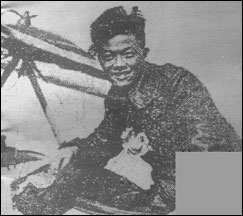 W
WAn Chang-nam was the first Korean aviator.
 W
WAn Jung-geun, sometimes spelled Ahn Joong-geun, was a Korean-independence activist, nationalist, and pan-Asianist.
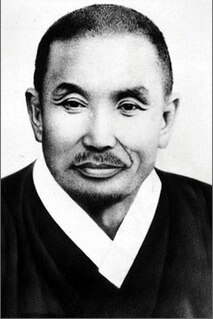 W
WCho Man-sik was a nationalist activist in Korea's independence movement. He became involved in the power struggle that enveloped North Korea in the months following the Japanese surrender after World War II. Originally, Cho was supported by the Soviet Union for the eventual rule of North Korea. However, due to his opposition to trusteeship, Cho lost Soviet support and was forced from power by the Soviet-backed communists in the north. Placed under house arrest in January 1946, he later disappeared, and is generally believed to have been executed in the North Korean prison system soon after the start of the Korean War.
 W
WChoe Sang-rim(Korean: 최상림) was a Korean independence movement activist, Presbyterian priest, and educator during the Korea's independence movement.
 W
WChu Ki-chol was a Korean Presbyterian minister and martyr. After having dropped out of Yonhi College due to poor health and being briefly associated with the March 1st Movement for the independence of Korea, Chu attended a faith meeting of Kim Ik-du. Thereafter, he sought a career in ministry, enrolling first at the Pyongyang Theological Seminary becoming a deacon. Chu was ordained a minister in 1926 and served as one in Pusan, Masan, and Pyongyang.
 W
WTatsuji Fuse was a Japanese lawyer and social activist. Fuse was posthumously awarded the Order of Merit for National Foundation in 2004 by the South Korean government for his efforts for Korean independence movement.
 W
WHaile Selassie I was Emperor of Ethiopia from 1930 to 1974. Prior to his coronation, he had been the Regent Plenipotentiary of Ethiopia from 1916. He is a defining figure in modern Ethiopian history, and the key figure of Rastafari, a religious movement in Jamaica which emerged shortly after his reign as an emperor in the 1930s. He was a member of the Solomonic dynasty who traced his lineage to Emperor Menelik I, the son of King Solomon and Makeda the Queen of Sheba.
 W
WHong Jin, also known as Hong Myeon-hui, was a leader of the Korean independence movement. He is also sometimes known by his pen name Mano, and his Christian name, Andre.
 W
WHomer Bezaleel Hulbert was an American missionary, journalist and political activist who advocated for the independence of Korea.
 W
WJang In-hwan was a Korean independence activist. He is best known along with Jeon Myeong-un for his role in the 1908 assassination of Durham Stevens, a former diplomat and Japan lobbyist.
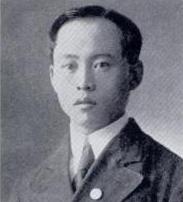 W
WJeon Myeong-un was a Korean independence activist. He is best known along with Jang In-hwan for his role in the 1908 assassination of Durham Stevens, a former American diplomat in Japan who was later appointed as an advisor to the Joseon Dynasty government.
 W
WJi Cheong-cheon, also known as Yi Cheong-cheon, was a Korean independence activist during the period of Japanese rule (1910–1945). He later became a South Korean politician. His name was originally Ji Seok-gyu , but he took the nom de guerre Ji Cheong-cheon, meaning "Earth and Blue Sky", while leading Korean guerrilla forces against the Japanese. He also went by Ji Dae-hyoung, Ji Su-bong, Ji Eul-gyu, Lee Cheong-Cheon, and Lee Dae-hyoung to hide his identity from Japanese forces while conducting military independence activities. Used the pen name Baeksan, meaning White Mountain.
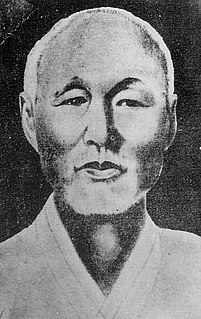 W
WKang Woo Kyu was a doctor of Korean medicine and a fighter for Korean independence during the Japanese colonial period. In 1919, Kang tried to assassinate Saitō Makoto, who was serving as the Governor-General of Korea, but failed.
 W
WKim Hong-il was a Korean independence activist and a general of the Second Sino-Japanese War and the Korean War, who later became a diplomat and politician in South Korea. Born in North Pyongan, he did his early schooling in China and Korea, and had a brief career as a teacher before his connections with the nascent Korean independence movement led to his imprisonment. He fled into exile in China in 1918, and served in the Kuomintang's National Revolutionary Army from 1926 to 1948, following which he moved to the newly independent South Korea to join the Republic of Korea Army. He commanded South Korea's I Corps during the first year of the Korean War, and was then sent to Taipei as South Korea's ambassador to the Republic of China, which by then had retreated to Taiwan. His assignment there ultimately lasted nine years. He returned to South Korea in 1960 following the April Revolution which ended the rule of Syngman Rhee, and served briefly as Minister of Foreign Affairs under the Park Chung-hee junta. He ran for the National Assembly, first unsuccessfully in 1960 and 1963, and was then elected in 1967 and became a major figure in the opposition New Democratic Party.
 W
WKim Hyong-gwon was a Korean revolutionary. He is known for attacking a Japanese police station in Japanese-occupied Korea and subsequently dying in Seoul's Seodaemun Prison where he was serving his sentence.
 W
WKim Kyu-Sik, also spelled Kimm Giusic and Kimm Kiusic, was a Korean politician and academic during the Korean independence movement and a leader of the Provisional Government of the Republic of Korea. Kim served in various roles in the provisional government, including as foreign minister, ambassador, education minister and finally as the vice president from 1940 until the provisional government's dissolution on March 3, 1947. Kim's nicknames included Yoosa(우사), Kummun(금문), KimSung(김성), and JukJeok(죽적).
 W
WKim Young-sam was a South Korean politician and activist who served as President of South Korea from 1993 to 1998.
 W
WKwon Ki-ok, or Quan Jiyu in Chinese, was the first Korean female aviator, as well as one of the first female pilots in China. She went in exile in China during the Japanese occupation of Korea, and became a lieutenant colonel in the Republic of China Air Force. She returned home after the independence of Korea and became a founder of the Republic of Korea Air Force.
 W
WLee Bong-chang was a Korean independence activist during the Japanese occupation of Korea. In 1932, he attempted unsuccessfully to assassinate Japanese emperor Hirohito with a hand grenade, which became known as the Sakuradamon Incident.
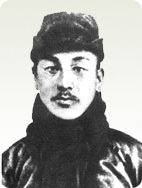 W
WLee Hoe-Yeong or Lee Hoe-Young, also known by his pen name Woodang, was a Korean independence activist, anarchist and one of the founders of Shinheung Military Academy in Manchuria. He used his entire fortune worth about two trillion won in today's value to fight against the Japanese occupation of Korea. He is the elder brother of Lee Si-Yeong, future Vice President of the Republic of Korea.
 W
WMin Yeong-hwan was a minister of the Korean Empire and known as a conservative proponent for reform. He was born in Seoul into the powerful Yeoheung Min clan and committed suicide as an act of resistance against the Eulsa Treaty imposed by Japan on Korea. He was an adoptive nephew of Empress Myeongseong. He is remembered today for his efforts on behalf of Korean independence in the waning days of the Joseon dynasty and a statue to his memory now stands near the gates of Seoul's Changdeok Palace.
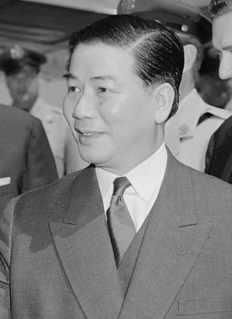 W
WNgô Đình Diệm was a Vietnamese politician. He was the final prime minister of the State of Vietnam (1954–55), and then served as President of South Vietnam from 1955 until he was captured and assassinated during the 1963 military coup.
 W
WPark Chung-hee was a South Korean politician and army general who served as the leader of South Korea from 1961 until his assassination in 1979, ruling as an unelected military strongman from 1961 to 1963, and as the country's third President from 1963 to 1979.
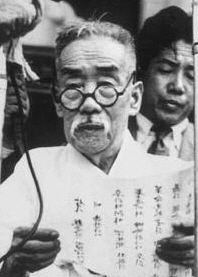 W
WSeongjae Yi Si-yeong was a Korean politician, independence activist, educator and neo-Confucianist scholar. He was Vice President of South Korea from 1948 to 1951. Yi resigned after the National Defense Corps incident of 1951. His nickname was Seongjae or Sirimsanin. Before the Japan–Korea Treaty of 1910, he had served for Joseon as the Governor of South Pyongan Province and the President of Hansung Law Court.